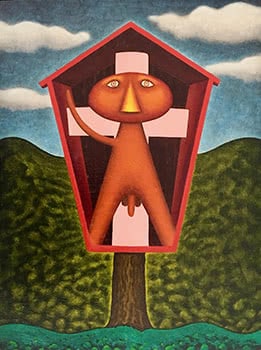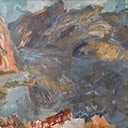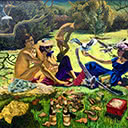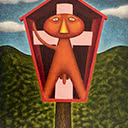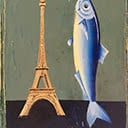A Calvary for Jim
41 x 31 cm
est. $50,000 - 75,000
Provenance: Barry Lett Galleries Chunn Family Collection
Meeting Baxter in 1958, Illingworth was filled with a sense of antagonism that flared into hostile argument. Perhaps it was religion that got them riled: Baxter had just become a Catholic. Despite his use of Christian iconography, Illingworth was an atheist, albeit one who believed that the role of the artist was to express the natural man: There is no god, but there should be an ideal, a purity to look to he wrote.
Both painter and poet chafed against the restrictions of puritan New Zealand society and lampooned straitlaced conformity in their art. For Baxter, the crucifixion of Jesus Christ was a symbol of divine love for humanity. He laced his poem, Ballad of Calvary Street with irony: bloodred roses bloom on a trellis, ignored by a couple 'clogged dumb by habit', trapped in a loveless marriage in kiwi suburbia.
A Calvary for Jim may be a portrait of the poet as a kind of seer, his brown eyes soulful, and his arm upraised like a prophet or preacher. Or it could be a depiction of the subject in Baxter's poem, The Māori Jesus - minus his blue dungarees. The figure is rendered smooth and hairless, as if carved of wood, and the form is geometricized. Illingworth had a rationale for this: The shape of my heads I take from that which nature has drafted as the shape strongest for protection (seen in such as an egg). My bodies come from the pyramid. The head I make is often to act as a canopy against nuclear fallout.
Time spent together in Dunedin, Baxter as Burns Fellow 1966-67 and Illingworth as the first Frances Hodgkins Fellow at the University of Otago in 1966, cemented their relationship as fellow travellers who believed in the power of politically and socially-engaged art to change the world. Jim Baxter said you are the warrior of our tribe Mike, and I was not old enough for that responsibility and he embarrassed me. Therefore I knew that one day he would be right.
Both men had married Māori women and then sought to live bohemian lives in Catholic settlements. In 1968, Baxter went up the Whanganui River to Jerusalem where the Sisters of Compassion had their convent. By August 1969 he had adopted the Māori version of his name, Hemi, and founded a commune. Illingworth retreated to Puhoi (the Māori translates as slow water) an hour north of Auckland where Baxter visited him at Easter in 1969. The riverside town had coincidentally been built by real Bohemians from Germany on 29 June 1863 - 63 years to the day before Baxter's birth in Dunedin. On its outskirts stands the roadside shrine or calvary depicting Christ on the cross which provided this painting with its motif. Illingworth described the subject of the crucifixion as the deepest known symbol of western man … therefore the hardest for the artist to work with and succeed in creating a new work of art. Having tackled Adam and Eve early in his career (and been censured for obscenity), A Calvary for Jim was an important cross on the way in Illingworth's own development as a painter.
Linda Tyler
In My Life
Art to me is everything. The art of cooking, the art of music, the art of writing, the art of speech and of listening, the art of the moving picture. All art has meaning. All art matters.
Human Beings making art is the salt and pepper to our lives and some of the most moving art, the best seasoning I've ever tasted has been the art of the New Zealand painter and their paintings. I feel lucky to have been born when I was. And that's not just because of The Beatles ( well, not quite ). From the middle of the twentieth century the artists of this country have done us proud. They are the Paint Blacks.
My father Jerry had a natural eye. He always bought an image, never just a name. He was blessed that way and I was blessed to have been brought up in his house. A house of many colours. I was also blessed with having been brought up on my mother's cooking. Doubly blessed.
My first memory of pictures in our family home were classic 'cover versions'. Van Gogh's Cafe Terrace At Night by the front door, his Almond Blossom in the hallway. Michelangelo's Madonna with Child above the green telephone by the kitchen door and, of course a heavy gold framed mirror hanging over the fireplace. A young boy notices these things.
But soon enough along came the burnt orange motorway landscapes of Robert Ellis (from the air - he had been an RAF pilot), the vigorously slurped paint of Toss Woollaston as he splashed the rivers and mountains onto the canvases to capture the Wild West Coast of Jerry's upbringing.
Dear Von was no slouch either. It was her eye that caught Dick Frizzell's Fabricant Société Anonyme Énigme and pinned it up onto the glossy white painted brickwork of the kitchen wall. Pre-vogue. International. Stunning!
Of all the works that hung around the family's eyes and ears over the years Jacqueline Fahey's Luncheon on the Grass got the lions' share of the visitors' comments. That and Michael Illingworth's A Calvary for Jim. Mind you an awful lot of those visitors were teenage boys and girls so no surprise there.
I will never forget one afternoon in 1972, sitting among these wonderful pictures in the gallery like living room of the middle terrace house at the top Parnell Road as my brother Michael, with four friends, tried out their new band on me. Split Enz was born. I was the one single audient to their very first performance. Just those paintings and me. As Black Adder might have said, I've still got the preliminary sketch right here in my head. There amongst all the beautiful paintings in my life.
Geoffrey Chunn

